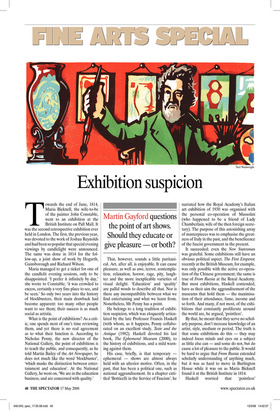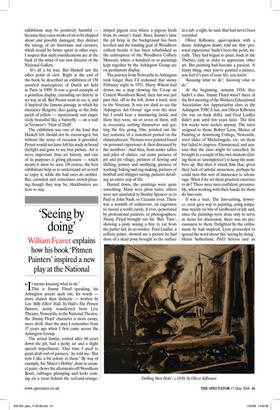Exhibition suspicion
Martin Gayford questions the point of art shows.
Should they educate or give pleasure — or both?
Towards the end of June, 1814, Maria Bicknell, the wife-to-be of the painter John Constable, went to an exhibition at the British Institute on Pall Mall. It was the second retrospective exhibition ever held in London. The first, the previous year, was devoted to the work of Joshua Reynolds and had been so popular that special evening viewings by candlelight were announced. The same was done in 1814 for the follow-up, a joint show of work by Hogarth, Gainsborough and Richard Wilson.
Maria managed to get a ticket for one of the candlelit evening sessions, only to be disappointed. ‘I prefer it infinitely by day,’ she wrote to Constable; ‘it was crowded to excess, certainly a very fine place to see, and be seen.’ So only two years into the history of blockbusters, their main drawback had become apparent: too many other people want to see them; their success is as much social as artistic.
What is the point of exhibitions? As a critic, one spends most of one’s time reviewing them, and yet there is no real agreement as to what their function is. According to Nicholas Penny, the new director of the National Gallery, the point of exhibitions is to teach the public, and consequently, as he told Martin Bailey of the Art Newspaper, he does not much like the word ‘blockbuster’, ‘which masks the distinction between entertainment and education’. At the National Gallery, he went on, ‘We are in the education business, and are concerned with quality.’ That, however, sounds a little puritanical. Art, after all, is enjoyable. It can cause pleasure, as well as awe, terror, contemplation, relaxation, horror, rage, pity, laughter and the more inexplicable varieties of visual delight. ‘Education’ and ‘quality’ are pallid words to describe all that. Nor is there any incompatibility between what we find entertaining and what we learn from. Nonetheless, Mr Penny has a point.
He belongs to a long tradition of exhibition suspicion, which was eloquently articulated by the late Professor Francis Haskell (with whom, as it happens, Penny collaborated on an excellent study, Taste and the Antique (1982). Haskell devoted his last book, The Ephemeral Museum (2000), to the history of exhibitions, and a mild warning against them.
His case, briefly, is that temporary — ephemeral — shows are almost always held with an ulterior motive. Often, in the past, that has been a political one, such as national aggrandisement. In a chapter entitled ‘Botticelli in the Service of Fascism’, he narrated how the Royal Academy’s Italian art exhibition of 1930 was organised with the personal co-operation of Mussolini (who happened to be a friend of Lady Chamberlain, wife of the then foreign secretary). The purpose of this astonishing array of masterpieces was to emphasise the greatness of Italy in the past, and the beneficence of the fascist government in the present.
It succeeded; even the New Statesman was grateful. Some exhibitions still have an obvious political aspect. The First Emperor, recently at the British Museum, for example, was only possible with the active co-operation of the Chinese government; the same is true of From Russia at the Royal Academy. But most exhibitions, Haskell contended, have as their aim the aggrandisement of the museums that hold them — the maximisation of their attendance, fame, income and so forth. And many, if not most, of the exhibitions that constantly proliferate around the world are, he argued, ‘pointless’.
By that, he meant that they serve no scholarly purpose, don’t increase knowledge of an artist, style, medium or period. The truth is that some exhibitions do this — they may indeed focus minds and eyes on a subject as little else can — and some do not, but do cause a lot of pleasure to the public. It would be hard to argue that From Russia extended scholarly understanding of anything much, but it was as hard to move in Burlington House while it was on as Maria Bicknell found it at the British Institute in 1814.
Haskell worried that ‘pointless’ exhibitions may be positively harmful — because they cause works of art to be shipped about and possibly damaged, they distract the energy of art historians and curators, which would be better spent in other ways. I suspect that such considerations are at the back of the mind of our new director of the National Gallery.
It’s all a bit true. But Haskell saw the other point of view. Right at the end of the book he described an exhibition of 150 assorted masterpieces of Dutch art held in Paris in 1909. It was a good example of a pointless display, extending art history in no way at all. But Proust went to see it, and it inspired the famous passage in which his character Bergotte dies gazing at the little patch of yellow — mysteriously and exquisitely beautiful like a butterfly — on a wall in Vermeer’s ‘View of Delft’.
The exhibition was one of the kind that Haskell felt should not be encouraged, but without the sense of occasion it provided, Proust would not have left his study in broad daylight and gone to see that picture. Art is more important than art history, and one of its purposes is giving pleasure — which means it must be seen. Of course, the best exhibitions help us to understand art as well as enjoy it, while the bad ones do neither. But, crowded and sometimes crowd-pleasing though they may be, blockbusters are here to stay. striped pigeon cree where a pigeon feeds from its owner’s hand. Since Jimmy’s time the pit heap in the background has been levelled and the winding gear of Woodhorn colliery beside it has been refurbished as the centrepiece of the Woodhorn Colliery Museum, where a hundred or so paintings kept together by the Ashington Group are on permanent display.
The journey from Newcastle to Ashington took longer than I’d reckoned that snowy February night in 1971. Harry Wilson had drawn me a map showing the Co-op on Central Woodhorn Road; their hut was just past that, off to the left, down a track, next to the Veterans. It was too dark to see the ‘Ashington Art Group’ sign over the door but I could hear a murmuring inside and there they were, six or seven of them, still in overcoats, settling themselves and getting the fire going. One pointed out the key sentence of a statement posted on the chimneybreast: ‘Pictures were painted based on personal experience & then discussed by the members.’ And then, from under tables and piles of clutter, out came pictures of pit and pit village, pictures of hewing and shifting, joinery and smithying, pictures of washing, baking and rug-making, pictures of football and whippet racing, pictures detailing an entire way of life.
Dusted down, the paintings were quite something. Many were plain naive; others were not unrelated to Stanley Spencer or to Paul or John Nash, or Cézanne even. There was a warmth of endeavour, an eagerness to record a world rarely, if ever, penetrated by professional painters, or photographers. Jimmy Floyd brought out his ‘Bait Time’, showing a pony nosing a bite to eat from the putter lad, its co-worker. Fred Laidler, a colliery joiner, showed me a picture he had done of a dead pony brought to the surface in a tub: a sight, he said, that had never been recorded.
Oliver Kilbourn, quiet-spoken with a dense Ashington drawl, told me that ‘personal experience’ hadn’t been the point, initially. They had begun to paint, back in the Thirties, only in order to appreciate other art. But painting had become a passion. ‘A funny thing, once you’ve painted a picture, you feel it’s part of your life, you know.’ ‘Knaaing what to de’; ‘knowing what to do.’ At the beginning, autumn 1934, they hadn’t a clue. Jimmy Floyd wasn’t there at the first meeting of the Workers Educational Association Art Appreciation class in the Ashington YMCA hut, nor Oliver Kilbourn (he was on back shift), and Fred Laidler didn’t join until ten years later. The first few weeks were useless anyway. The tutor assigned to them, Robert Lyon, Master of Painting at Armstrong College, Newcastle, tried slides of Michelangelo, etc. on them but failed to impress. Flummoxed, and anxious that the class might be cancelled, he brought in a couple of his own students (listing them as ‘unemployed’) to keep the numbers up. But then it struck him that, given their lack of artistic awareness, perhaps he could turn this sort of innocence to advantage. What if he set them practical exercises to do? These were men confident, presumably, when working with their hands: let them do lino-cuts.
It was a start. The lino-cutting, however, soon gave way to painting, using walpamur mainly on bits of cardboard or ply and, since the paintings were done only to serve as items for discussion, there was no preciousness to them. Delighted by the enthusiasm he had inspired, Lyon proceeded to spread the word about this ‘seeing by doing’. Helen Sutherland, P&O heiress and an











































































 Previous page
Previous page